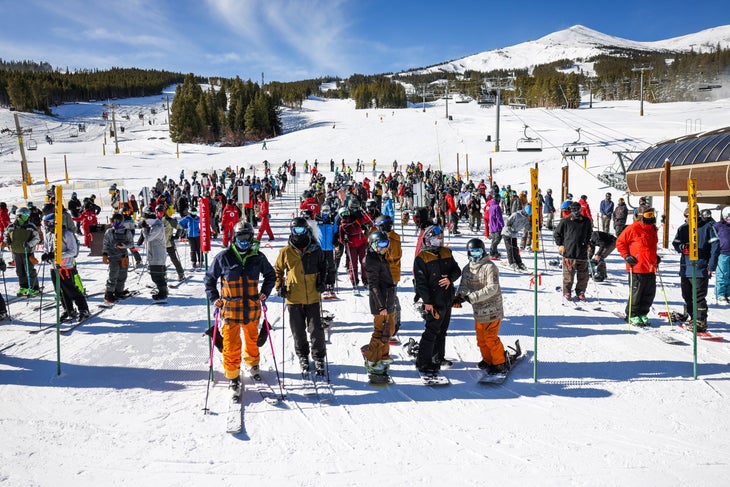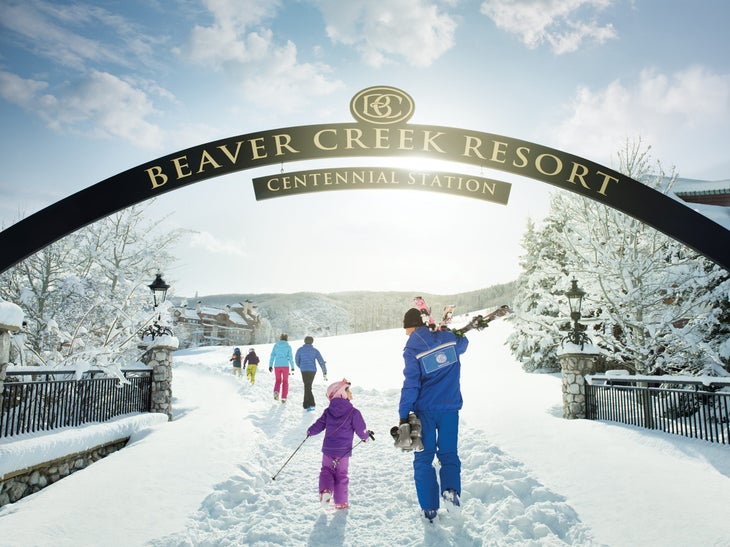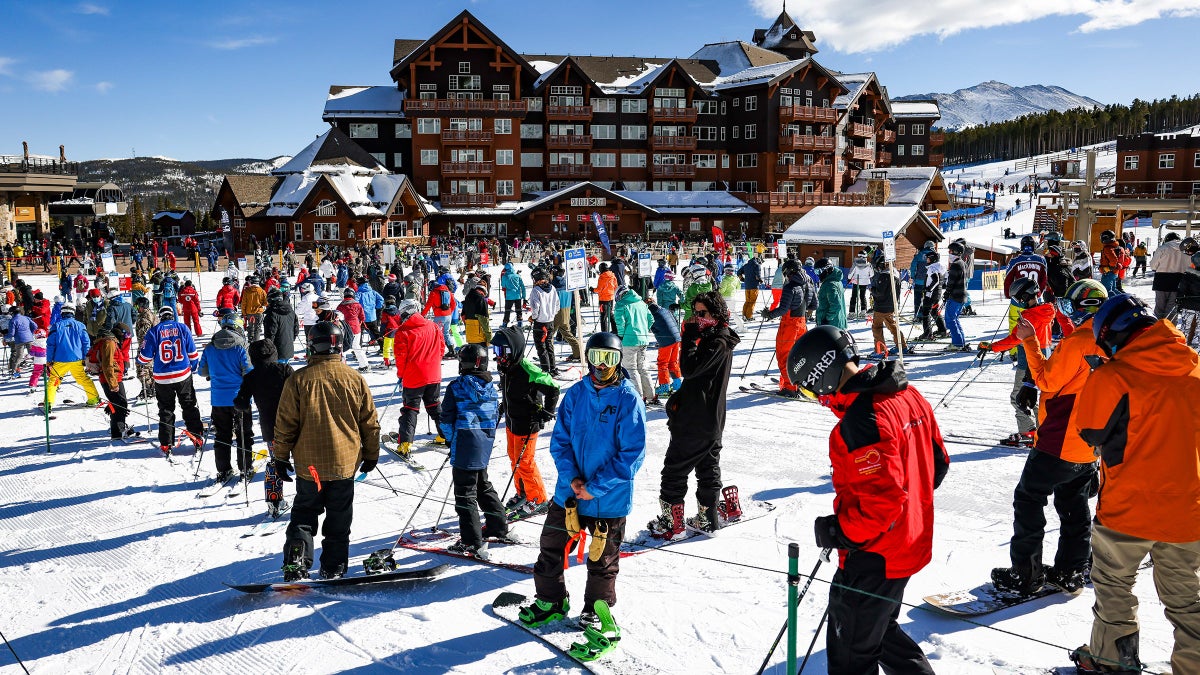Products You May Like
Receive $50 off an eligible $100 purchase at the Outside Shop, where you’ll find gear for all your adventures outdoors.
Sign up for Outside+ today.
In March 2021, Vail Resorts gave the snow-sports world a shock: prices for its multi-resort season pass, called the Epic Pass, would be slashed by 20 percent, from $979 to $783. Its Epic Local Pass, which grants access to fewer resorts, would also see a price cut, from $729 to $583. “We are excited to make it easier for everyone to move into a pass,” Vail’s then-CEO Rob Katz said in a press release, “and we remain fully committed to ensuring continuous improvements in the guest experience.”
Thanks to the price cut, and to an impressive portfolio of 40 resorts worldwide, Vail sold 2.1 million pre-purchased tickets and season passes for 2021–22, a 76 percent jump over 2019–20 figures. As a result, earnings jumped 30 percent from fiscal year 2020 to fiscal year 2021.
“Vail Resorts took really aggressive pricing action this year on the Epic Pass, and that was undoubtedly going to trigger high sales,” said Tom Foley, a ski-industry analyst and director of business intelligence at the travel research company Inntopia. “I think it might have exceeded their expectations.”
A Breckenridge, Colorado-based ski instructor who asked not to be named had a less generous assessment. Vail hasn’t had the staff to support the huge crowds they brought in, he said. “They left local resorts ill-equipped to deal with that burden.”
Eleven months after announcing its record sales, Vail is mired in a seemingly endless barrage of complaints, social media vitriol, and negative news stories. Customers across its vast empire are lodging daily complaints about congestion, long chairlift lines, and reduced operations. Skiers at Washington’s Stevens Pass have launched a petition to ask for a refund. Local newspapers have lambasted Vail for its drop in customer service. And across the internet, photos and humorous memes of Vail’s huge crowds have generated tens of thousands of likes and comments.
Vail has insisted that its deficiencies this season are a reflection of broader trends in the U.S. workforce, such as the housing crisis sweeping ski towns and the loss of labor due to the pandemic. And to be fair, 60 percent of the ski areas in the U.S. were unable to fill all open positions in the 2020–21 season, according to the National Ski Areas Association.
But interviews with over a dozen current and former Vail employees suggest the economy and the ongoing pandemic aren’t solely to blame. Vail’s record sale of ski passes has played a part, they said. The company’s dysfunctional internal policies, as well as its low wages, have also harmed its operating efficiency. According to these employees, who spoke on the condition of anonymity out of fear of retaliation, the company can be just as frustrating on the inside as it is in the lift lines.

One of the criticisms sources repeated was Vail’s ignoring feedback from its boots-on-the-ground employees, who have had a front-row seat for the problems on the slopes.
“It worries me that Vail isn’t listening to their local people,” said a snowboard instructor at Boston Mills, a 79-acre mountain in northeast Ohio that was acquired by Vail in 2019 as part of its much ballyhooed $264 million takeover of rival Peak Resorts and its 17 mountains.
In the case of Boston Mills, locals were irritated when Vail shortened the ski day (the resort used to stay open until 11 p.m. but now closes at 5 p.m. on weekends) and expanded the terrain park, which took up space typically reserved for beginner runs, crowding the available easy terrain. That congestion is especially irksome, noted one Boston Mills instructor, on a small mountain that features low vertical: “You’re talking about a place that has 300 vertical feet. People don’t drive two hours to ski all day here.” (Vail’s vice president of communications Sara Olson says local staff at each resort make decisions about daily operations.)
There’s frustration among Boston Mills staff—and locals, for that matter—with Vail’s inability to hire an adequate number of lift operators. The instructor blamed this on the position’s low pay: the job was advertised as paying $11.25 an hour, and even after Vail announced in January an end-of-season bonus of $2 an hour, Boston Mills’ wages are still far below, say, local amusement park Cedar Point’s offering of $20 an hour for seasonal workers. (Cedar Point has apparently had no trouble finding workers.)
The complaints extend far beyond Boston Mills. Employees and ex-employees at Vail properties, including Park City Mountain in Utah, Mount Snow in Vermont, Stevens Pass in Washington State, and Colorado’s Beaver Creek and Breckenridge, all voiced frustrations with Vail’s inability to hire seasonal workers.
“You could be a part-time retail associate and make a dollar more an hour than their starting wage for lift mechanics,” said a Park City Mountain employee who works in on-mountain operations. “They’ve given no incentive to stay at the company.”
“We have a lot of well-trained, qualified instructors who are making less than burger flippers at fast-food joints,” added a ski instructor at Breckenridge. (In an emailed statement to Outside, Olson said that Vail “made a significant investment” in wages and highlighted “the $2/hour bonus added to our employees’ compensation for the rest of the season.”)
For a company that boasts annual revenues just shy of $2 billion and controls a lion’s share of national skier visits (and, as a publicly traded company, has a fiduciary duty to shareholders), these may seem like small-scale problems. And Vail recently announced major improvements to many of its resorts, including a $320 million plan to build 21 new chairlifts across 14 resorts next season. But employees say that Vail’s wages are well below livable, especially in mountain towns experiencing soaring real estate prices and ever more second homes and vacation rentals.
In addition to wages, employees were concerned by what they see as a one-size-fits-all approach to resort management as well as by Vail’s ongoing efforts to “centralize corporate functions” through its headquarters in Broomfield, Colorado, as the company wrote in a 2019 statement. This process has included laying off members of resort marketing, finance, and human-resource teams over the last several years. But employees say that such centralization has created confusion and left mountains lacking key institutional knowledge.
One former Peak Resorts employee who worked in the marketing department said that soon after Vail’s acquisition, resort general managers felt they had less say over day-to-day operations—“what to groom, where to make snow, when to make snow.” Instead, regional directors and corporate employees in Broomfield took over decision-making.
“A lot of those regional directors and people in Broomfield weren’t really familiar with the intricacies of operating a ski resort in the Midwest or the East Coast, which need snowmaking early and often to maintain a proper snow surface,” the employee said. “They were used to snowmaking conditions like you find in Colorado, where you just make snow up until the Christmas holiday and then you stop because it’s supplemented by natural snow.” As a result, the employee said, Vail’s new acquisitions have seen a slower opening schedule.
Vail spokespeople say that an unusually balmy winter led to delays in opening trails to the public this year. “Regarding delayed openings of our resorts—that was the result of weather,” said Olson, Vail’s VP of communications. “At some resorts, like Park City Mountain, we had temperatures in the fifties and sixties, which is not conducive to even snowmaking. At others, like our Tahoe Resorts, the warm early season was followed by massive amounts of snow that took days to dig out from to ensure the terrain was safe to ski and ride on.”
Vail’s CEO, Kirsten Lynch, who was appointed to the role in November, added: “The early months of this ski and ride season were challenging for a variety of reasons, and I am proud of the tremendous work of all our teams who reacted quickly to execute improvements across our resorts. We now have nearly 100 percent of our terrain open at our ten largest resorts, with great progress at our regional and local resorts as well. Our goal is always to provide our guests an amazing experience and I am confident we have a great season ahead of us.”
Critics, however, point out that warm weather didn’t stop many of its rival resorts. “When the independent resorts have 50 percent of their terrain open, the Vail resorts have 20 percent of their terrain open,” said the former Peak employee. “They’re all in the same climate.” In Ohio, for example, Boston Mills didn’t open for the season until January 7, while Snow Trails in Mansfield (about an hour’s drive away) was open before Christmas. And though Stevens Pass opened on December 15, by mid-January about 60 percent of the terrain was still inaccessible—an unusually high percentage compared to other Washington resorts, which had most of their serviceable terrain open by then.
Employees also expressed dismay over the removal of on-site human-resources departments in favor of an outsourced web-based system—another casualty of Vail’s centralized approach—as a major pain point. Workers say it has caused a number of headaches. In one case, a ski instructor in Colorado offered to lend money to direct reports who were unable to reach anyone on the corporate team when their paychecks weren’t processed on time.
Vail says the new system makes HR support available daily. However, some employees expressed challenges getting in contact with HR, citing slow response times. “The dismissal of [individual] HR departments made it clear that they don’t care about employees,” added the Park City employee, explaining that the outsourced system is far less expedient. “HR now takes two to four days to reply.” (Olson, Vail’s communications VP, said: “We centralized our HR function to ensure consistency, scalability and best-in-class support across all of our resorts—which has been invaluable as we navigate this pandemic.”)
Employees suggested these internal problems, when matched with the low wages, make Vail less able to hire and retain new workers. “The past ten or 15 years there’s been a gradual acceleration of devaluing employees,” said a Beaver Creek ski instructor. “Vail has these core values: serve others, do right, be inclusive, drive value, do good, be safe, and have fun. Most of their core values they are not living up to.”

Conversations with customers from multiple Vail-owned resorts show an exasperated clientele who have had to wait in lift lines for upwards of 30 minutes and face delayed terrain openings. “This year has been horrible,” said Jon Sleep, a skier at Stevens Pass, where closed terrain—despite snowy conditions—has prompted mass complaints from customers. “Other resorts in my area are operating like normal.” (Vail has said that lift lines at its resorts were under a ten-minute wait time 90 percent of the time during the holiday.)
Boston Mills skier Heather Johnston Welliver said the long wait times are especially vexing, since that resort is so small. “I have kids and I want them to grow up skiing, just like I did,” she said. “They don’t love getting on all their gear and going to wait in lines that are 20 minutes long to go down the hill for 30 seconds.” Vail’s attempts to solve its lingering lift-line problem—launching a daily forecast of wait times in its app and implementing “phone free zones” in lift lines to make sure people aren’t distracted and further exacerbating the problem—have proven largely unsuccessful, employees say.
There is at least one source of hope: growing calls for accountability from mountain-town and ski-area locals. Ski-patrol unions in Breckenridge, Park City, and Stevens Pass reached contract agreements with Vail in the last few months. Other movements have been more grassroots, relying on social media and public comment to share grievances and demand action.
In early January, Stevens Pass local Jeremy Hunter Rubingh drafted a petition on Change.org that claims Vail not only failed customers but might also be in violation of the Washington Consumer Protection Act because it “deceived a substantial portion of the public” by selling passes while always “[intending] to keep 60 percent of the terrain and the majority of lifts closed for the season.” To date, the petition has racked up over 44,000 signatures, prompted other mountain communities to create petitions of their own, and caught the attention of the state’s attorney general after the office received over 80 complaints about the ski area.
“This was about being pro-worker and about being pro-skier, pro-snowboarder,” Rubingh told me. “This is about getting some positive changes, getting terrain opened, getting people paid. I think that’s why it resonated. It wasn’t just like, ‘We’re pissed, we hate Vail.’ It was like, ‘No, this is what it should be. Let’s do something.’”
At least with Stevens Pass, Vail has acknowledged its mistakes. In early January the resort replaced its general manager; two weeks later, it offered next season’s pass at the discounted price of $385 and finally opened up much of its closed terrain. (Olson, Vail’s VP of communications, added that it has made improvements in both staffing and terrain in the last few weeks, with 85 percent of the mountain now open.)
Rubingh has mixed feelings about Vail’s attempts at extending an olive branch. “It’s these specific business practices that have left Vail Resorts behind compared to other resorts,” he said. “Everyone has been hit by the pandemic. But why is it that it was so exacerbated with Vail Resorts’ properties?”
Not all of the grassroots campaigns have been so diplomatic. In March 2021, after Vail announced the price slash on its Epic Passes, Alex Kaufman, a Colorado-based skier who spent two decades working at resorts across the U.S., had a feeling that conditions were about to deteriorate. For $12, Kaufman bought the domain name epicliftlines.com; he then created a corresponding Instagram account. Kaufman’s premonition was, of course, all too accurate, and soon people—39,000 of them and counting—began flocking to his fledgling Instagram to air their grievances.
“This thing kind of blew up by basically just holding up a mirror to what was going on,” said Kaufman.
Kaufman pointed to a recent Wall Street Journal story about Vail’s troubles as evidence that this social media uproar might be inspiring real-world change. (And indeed Wall Street has taken notice: Vail’s stock has dropped 26.86 percent over the last three months, from $372.51 on November 5 to $272.44 on January 28.) “In the article, I saw the word pivot come out of the CEO’s mouth,” Kaufman said, referencing a seemingly trivial line in the Journal’s reporting, where Kirsten Lynch said Vail would be “willing to hear and change and pivot.”
“That’s been the most important thing,” Kaufman said. “Now, every analyst on every call is going to be asking her about how the pivot is going.”
